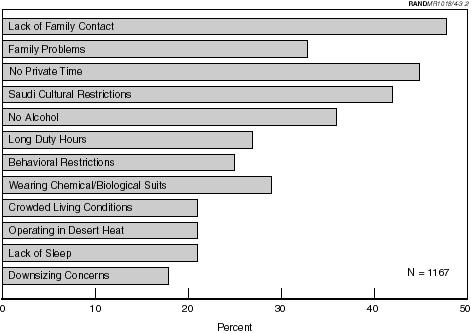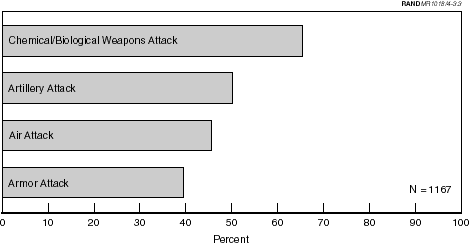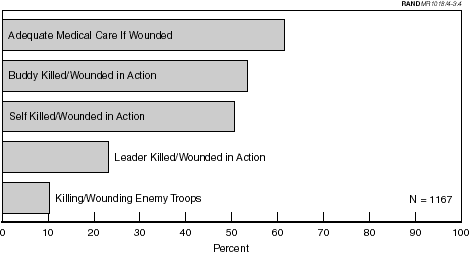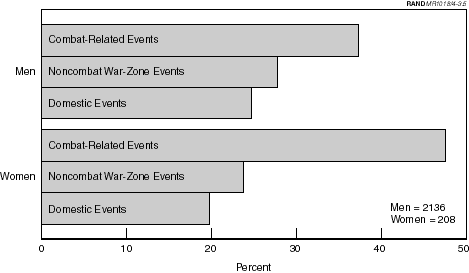
Figure 3.1--Gulf War Health Assessments Timeline
Apprehensions about Iraqi military capabilities--including the possibility of terrorist attack and infiltration by Iraqi special forces--fueled by news coverage, heightened fears concerning the danger of an eventual military engagement. Casualty forecasts were reported by the media to be as high as 20,000-50,000, with projections frequently interpreted by soldiers to refer to combat mortality rates rather than total combat-related morbidity (Wright, Marlowe, and Gifford, 1991). Casualty estimates for some units were projected to be as high as 50-80 percent for the ground war (Ford et al., 1992).
Iraq was known to have used chemical weapons against Iran and in suppressing its own people, prompting widespread concern about the potential use of deadly chemical or biological warfare agents and the ever-present need for vigilance against such attacks. Apprehension and uncertainty about possible attacks, the effectiveness of defensive suits, and the possible side effects of prophylactic agents aimed at mitigating consequences of exposure to chemical weapons served as a constant backdrop to the day-to-day hardships of preparation for possible war. Constant training for a chemical and biological attack and numerous alarms indicating possible chemical detections increased the salience of this potential threat. In addition, the threat of random SCUD missile attacks--borne out by the destruction of a reserve unit barracks facility and the resulting death of 29 persons (Perconte et al., 1993b)--was theater-wide.
As noted earlier, some experienced traditional combat activities, although relatively few. Moreover, in the aftermath of the highly successful air and ground offensives, many personnel--including noncombatants--were exposed to evidence of widespread devastation, including the deaths of tens of thousands of Iraqis, causing some personnel to experience guilt. "It was difficult not to feel like a bully after having seen the rag-tag bunches of ill-clothed young men who constituted the fifth largest fighting force in the world" (Holsenbeck, 1996).
Finally, veterans--many of whom had little time between leaving the theater and returning to community life (Rodell, Cooley et al., 1992)--reentered a society soon to be confronted by widespread and unrelenting concerns about the possible negative health effects of Gulf War service. Even before the war had ended, efforts were underway to examine potential health problems associated with Gulf War service (e.g., U.S. Army Environmental Hygiene Agency, 1994). Moreover, in 1992, not long after the end of hostilities, two separate incidents of possible outbreaks of symptoms involving units deployed to the Persian Gulf received widespread media attention (Berg, 1994; DeFraites et al., 1992). Although no definitive conclusions have yet been drawn concerning the origins of these symptoms, these reports served to further sensitize veterans to possible health issues associated with Gulf War service. Ambiguity concerning the origins of health problems reported by some Gulf War veterans continues to this day, with media accounts (e.g., see Fumento, 1995) and conflicting reports (Presidential Advisory Committee, 1996; General Accounting Office, 1997; House Committee, 1997) contributing to an ongoing, stress-provoking climate of distrust, recrimination, and suspicion of government cover-ups and obstruction (cf. Presidential Advisory Committee, 1997).

Figure 3.1--Gulf War Health Assessments Timeline
The corps-level mental health team of the 18th Airborne Corps similarly noted a relationship between being newly assigned to a unit and the type of problems experienced in-theater (Ruck, 1996). Of the 108 soldiers this team treated between mid-November 1990 and March 1991, nearly 20 percent had been with their unit less than three months before they were deployed. A majority of these soldiers had preexisting problems. In general, they were regarded as having poor coping skills that were exacerbated by the deployment (Ruck, 1996).
Mental health services provided to the U.S. Army 7th Corps by the 531st Psychiatric Detachment between late December 1990 and early February 1991 also covered the period encompassed by the air war. Of a total 158 patients treated, 76 percent were soldiers with stress reactions (McDuff and Johnson, 1992). The most common stressors identified were fatigue, cold, sleep deprivation, poor unit leadership and poor morale, and perceived threats to personal safety, which increased dramatically after the start of the air war.
Observations from the initial set of interviews suggested that problems seemed related to factors that existed before the deployment. During the first few months in the Gulf, the stresses and intense interpersonal contact associated with deployment often exacerbated problems that existed at the unit's home station. Similarly, soldiers' individual problems that existed before the alert appeared to have continued or worsened after deployment (Wright et al., 1995; Gifford, 1996).
Results of the WRAIR survey indicated that a substantial number of personnel reported experiencing significant stress during the build-up phase. Stressors could be broadly divided into two categories: (1) those pertaining to harsh living conditions/family-civilian concerns; and (2) those pertaining to the anticipation of combat. With respect to the first category, the circumstances most commonly reported as provoking high levels of stress included uncertainty of the tour length, ambiguity of the mission, separation from and limited contact with family and home, austere physical environment, and crowded living conditions in-theater.[8]
The WRAIR in-theater survey results of the 1167 soldiers who had completed questionnaires during November-December 1990 helped to quantify some of the interview observations (Wright et al., 1995). Circumstances experienced during the build-up phase rated by U.S. service personnel as causing "quite a bit (4)" to "extreme (5)" stress, are displayed in Figure 3.2.[9]

Figure 3.2--Non-Combat Stressors: Build-Up Phase
(Percent of Gulf War Veterans
Citing Factor as Causing "Quite a Bit" or "Extreme" Stress)

Figure 3.3--Combat Anticipation Stressors: Build-Up Phase
(Percent of Gulf War Veterans Citing Anticipatory Concerns as Causing
"Quite a Bit" or "Extreme" Stress)

Figure 3.4--Combat Casualty Anticipation Stressors: Build-Up Phase
(Percent of Gulf War Veterans Citing Anticipatory Concerns as Causing
"Quite a Bit" or "Extreme" Stress)
In addition, another WRAIR survey of 748 combat arms soldiers deployed from Germany to Operations Desert Shield and Desert Storm found a similar set of pre-combat concerns regarding a variety of enemy threats. The percentages of soldiers reporting "quite a bit" to "extreme" stress were similar to those reported in Figures 3.3 and 3.4, including the potential use of chemical or biological agents, the possibility that they or a buddy might be wounded or killed in combat, and the possibility of artillery, aircraft, or tank attack (Martin et al., 1992). Importantly, this survey was conducted just several weeks before the ground war and administered to junior and mid-level enlisted soldiers in remote desert staging areas near the Iraqi border; it therefore measures forward deployed combat units' experiences.
The Fort Devens survey used both structured and open-ended questions to elicit information about veterans' self-reported exposure to a number of potential stressors. Three assessment instruments were used. The first instrument consisted of a set of combat exposure items involving minor modifications of previously validated combat exposure questions (Gallops et al., 1981). Known as the Laufer combat scale and developed to assess Vietnam combat experiences, this instrument contained items describing exposure to actual combat, such as whether an individual had received friendly or incoming fire; whether his or her unit had been ambushed, attacked, or received sniper fire; and whether he or she had seen either Americans or other troops killed or wounded (Gallops et al., 1981; Wolfe et al., 1993). A second instrument, known as the ODS expanded checklist, consisted of the original Laufer items and 23 additional items pertinent to the Persian Gulf War (e.g., exposure to chemical alert). The ODS expanded checklist was used to create the ODS Combat Exposure Scale. An index of overall war-zone stress exposure was created by adding positively-endorsed items from the Laufer combat and ODS exposure scales. A third instrument asked respondents to describe, in open-ended fashion, the single most distressing incident during deployment.
The survey focused on several stressor categories: (a) wartime activities (e.g., troop engagements); (b) nontraditional wartime events (e.g., combat war-zone events specific to the Gulf War and significant noncombat war-zone occurrences); and (c) non-war-zone, deployment-related experiences (e.g., vocational, domestic, and psychological stressors).
The survey found that approximately two-thirds of the Fort Devens veterans reported very little exposure to combat events as measured by the traditional Laufer combat scale.[11] Fifty-six percent of male veterans and 58 percent of female veterans scored in the low range for traditional combat events. Only 3 percent of male veterans and 3 percent of female veterans reported high levels of exposure to traditional combat activities. No significant differences were found between male and female veterans on mean Laufer combat scores.
Because of the inclusion of ODS-relevant items, the expanded ODS exposure scale yielded higher mean scores than the Laufer combat scale. The ODS exposure scale indicated that the three most commonly endorsed war-zone experiences reported by Fort Devens male and female veterans were:

Figure
3.5--Single Most Stressful Gulf War Experience: Ft. Devens Survey
(Percent
of Gulf War Veterans Citing Factor as Most Stressful)
Consistent with the above findings are those of Sutker et al. (1993), who surveyed 215 Louisiana Army National Guard and Army Reserve troops activated to service in the Persian Gulf. Four to six months following ODS, these soldiers also were asked in open-ended fashion to list up to three of the most stressful conditions or events experienced during Persian Gulf duty. Content analysis of the written replies identified three major categories of stress: hardships associated with separation from family and home, fear of SCUD-missile and other military attacks, and discomfort related to the austere desert physical environment.
Debriefings conducted by the Portland VA Medical Center with a small group of ODS veterans and their spouses (N=80) up to six months following their return from the Persian Gulf also found that important stressors identified included family separation, rapidity of the call-up, hardships associated with the austere desert physical environment, fear of SCUD-missile and other military attacks, and indirect exposure to combat such as being sent into minefields (Ford et al., 1992). In addition, some female veterans reported instances of sexual harassment by allied troops (Ford et al., 1992).
The survey compared active-duty and reserve veterans, as well as deployed and nondeployed personnel, with respect to perceived sources of Gulf War theater stress, perceived levels of current stress, causal attributions concerning present problems, and the importance of deployment stressors compared to other recent life events.
Our review of this study focused on deployed personnel and comparisons of active-duty to reserve personnel. As part of the self-administered survey, both deployed active-duty and reservist personnel were asked whether they had experienced various events during their deployment. If they experienced the event(s), then they were asked the extent to which they found the event or events stressful. An overall finding from this study was that, two to three years following the Gulf War, many veterans rated a number of experiences as being moderately to extremely stressful. The general pattern and magnitude of reported stressors were similar for both active-duty and reserve deployed samples, as summarized below. Moreover, this pattern is similar to the results from the two Ft. Devens surveys that showed a range of stressors, including those associated with combat, exposure to other traumatic wartime events, living and working conditions in-theater, and domestic stressors.
A substantial number of respondents in this study reported combat-related experiences as being moderately to extremely stressful (WRAIR 1994, pp. A-19, A-22):
Reserve Deployed (N=764)
In terms of exposure to traumatic events, in the WRAIR study of Pennsylvania and Hawaii Gulf War veterans, both deployed active-duty and reserve personnel rated their concerns similarly about the threat of SCUD-missile and chemical-weapons attacks. Eighty-three percent of reserve and 77 percent of active-duty deployed troops experienced the threat of SCUD missile attack. Sixty-nine percent of reserve and 65 percent of deployed active-duty troops rated SCUD missile alerts as being moderately to extremely stressful. Twenty-four percent of reserves and 76 percent of active-duty deployed troops experienced the threat of enemy chemical weapons or agents; approximately 68 percent of these rated this threat as being moderately to extremely stressful.
Waiting for deployment to the Gulf was rated by 72 percent of deployed reserve troops (as compared to 61 percent of deployed active-duty personnel) as being moderately to extremely stressful. Stressors that both groups of deployed troops associated with living and working conditions included: boredom, operating in desert climates, long duty days, extended periods in chemical or biological protective gear, not getting enough sleep, crowding in base camps, lack of private time, and physical workload.
In terms of stressors associated with home, approximately 80-85 percent of active-duty and reserve deployed personnel experienced lack of contact with family and roughly 40 percent reported illness or problems back home. Approximately 70 percent of deployed reservists and 66 percent of deployed active-duty personnel rated lack of contact with family as being moderately to extremely stressful. Approximately half of deployed reserve and active-duty personnel also rated illness or problems back home as being moderately to extremely stressful.
The WRAIR study also attempted to determine current levels of life stress in deployed and nondeployed personnel and to assess the degree to which veterans attributed their present-day problems to experiences during ODS/S. To address this issue, personnel responded to a checklist of potential life stressors, including the degree of stress they experienced in the past two weeks with respect to each circumstance. In general, results revealed that deployed troops tended to report higher levels of current life stress in a number of domains than did nondeployed personnel. This finding was consistent across both active-duty and reserve personnel.
Veterans were also asked about their present levels of life stress and to indicate what caused most of their recent problems. Deployed troops reported more current concerns than did nondeployed personnel. For example, 40 percent of both deployed active-duty and reserve troops reported at least moderate concern in the past two weeks regarding personal health matters, as compared to 21 percent of nondeployed active duty personnel and reservists. Similarly, approximately 20 percent of active-duty and reserve deployers noted moderate or greater concern in the past two weeks regarding their ODS/S experiences (e.g., thoughts of fellow service personnel being killed or wounded in the Gulf War, or their relationship with their spouse or significant other since their return from Gulf War service).
Reservations about the lack of general applicability of these findings stem from two primary concerns: low survey-completion rates and nonrandom respondent selection procedures. With respect to survey response rates, some key studies reported levels that only slightly exceeded 30 percent (e.g., WRAIR, 1994). One potential bias associated with low participation is that the surveys may have overrepresented individuals who have been concerned about or who have experienced stress or illness. If this assumption is true, then estimates of self-reported stress exposure and perceived stress could be somewhat inflated.
The partial reliance on retrospective studies and the attendant problem of distorted recall also may have compromised some of these studies. Some evidence suggests, for example, that the perception of stress may become amplified over time (Wolfe et al., 1996), and additional data indicate that recall of exposure to stressful circumstances may be biased in the direction of reporting greater exposure with the passage of time (Southwick et al., 1997). The fact that retrospective recall of perceived stress as well as actual exposure to objective events was greater at follow-up than at the initial assessment is consistent with the argument that memories of war-related stressors are influenced by intervening events, life changes, and experiences.
With respect to nonrandom respondent selection, most of the available information was derived from combat support and combat service support units, with relatively little representation of combat units. In general, sampling issues call into question the representativeness of study findings. For example, the Fort Devens Reunion Survey appeared largely to have missed combat veterans, sampling mostly those who saw little or no combat. Further, reservists in general were more highly represented than active-duty troops. The lack of data from combat units represents a serious limitation, because these were the units most likely to have been exposed to the high-magnitude stressors.
Moreover, insights gained from in-theater psychiatric evaluations pertain mostly to the staging areas and the build-up phase, where the stressors resulted primarily from coping with family separation, austere and crowded living conditions, uncertainty about the mission, and anticipation of combat. Thus, these assessments offer only a limited picture of the experiences of forward-deployed units or soldiers directly involved in the ground assault.
Another methodological limitation of some studies is that data are collapsed into groups in a manner that obscures potential differences (e.g., CS/CSS and actual combat units are combined, or active-duty and reservist troops are combined). These units would be expected to have vastly different wartime experiences and exposures.
[2]Several studies included assessments conducted at different time periods and so are noted more than once.
[3]Examples of preexisting problems included marital difficulties, poor work performance, poor anger control, somatization disorders, preexisting depression, and eating disorders.
[4]From late October 28, 1990, to March 10, 1991, the 528th Medical Detachment conducted a total of 514 psychiatric evaluations in-theater.
[5]The units visited by the WRAIR team included maneuver battalions from each of the three divisions established in the Persian Gulf, as well as support and headquarters units. Selection of units was done to ensure that the units interviewed were those that had been in the Persian Gulf the longest, were the most forward deployed, had lived under the most austere conditions, or had missions judged particularly stressful by their higher headquarters. When possible, interviewees represented the different organizational levels within a given unit (Wright et al., 1995).
[6]These data collection efforts obtained information on a range of topics. The focus of this chapter is limited to self-reported exposure and perceived stress. It is not possible to determine the survey response rate because the sampling was opportunistic and there was a need to be flexible in the method of distribution. So, surveys were either given directly to the soldiers by the research team or were distributed and collected by the chain of command (Gifford et al., 1996).
[7]Survey instruments differed for enlisted personnel and officers.
[8]A second round of open-ended individual and group interviews was conducted by WRAIR Human Issues Assessment Teams with select combat arms units and with Division Support Command and care personnel in the 82nd Airborne Division, the 101st Airborne division, the 1st Cavalry Division, and the 24th Infantry Division between November 12 and December 6, 1990. This qualitative assessment reports on a similar set of stressors related to the build-up phase (Marlowe et al., 1990).
[9]The survey's findings also supported some of the clinical observations made by the 528th Medical Detachment regarding family-related stresses. Of 530 soldiers interviewed, 25 percent indicated having moderate to major family problems prior to deployment, 21 percent reported having family problems that required them to be at home, and 7 percent indicated that they had actually requested being sent home to deal with family problems (Wright et al., 1995).
[10]WRAIR asked the 1167 soldiers about their pre-combat perceptions regarding combat losses and enemy capabilities. WRAIR developed a Combat Anticipation Stress Rating Scale that was divided into two categories: (a) items concerning enemy assets (e.g., weapons, equipment, systems), and (b) items regarding soldiers' perceptions relating to casualties and combat losses (e.g., buddy or leader wounded or killed in action; Wright et al., 1995).
[11]Southwick and Morgan (1992) similarly found in their study of 700 Connecticut National Guard personnel and reservists that although combat exposure was relatively limited, anticipation of missile attacks and the possibility of a massive ground war were stressors cited by many of the soldiers. Using the Combat Exposure Scale (CES), they also found that the majority of soldiers reported limited exposure to actual combat-related events.
[12]The self-generated stressor categories were based on 300 unique events described by the veterans, including: (1) combat/mission stressors--actual threat to life (e.g., SCUD missile attack, direct exposure to unit member, friend, or civilian being killed or wounded) during mission activity; (2) noncombat, war-zone stressors (e.g., unit member seriously injured or killed in nonmission activity); (3) domestic stressors (e.g., separation from family, family member ill, divorce or legal separation); (4) anticipation of war and combat activities (e.g., SCUD missile alert, fear of biological or chemical attack); (5) physical and situational attributes of the war zone (e.g., communication blockade, severe environmental conditions, continual tour of duty); (6) intra-unit "hassles" (e.g., personal conflict in unit, harassment, leadership failures); and (7) absence of a specific stressor.
[13]In May 1993, WRAIR conducted a survey of 5639 IRR soldiers to assess their experiences of stress or trauma exposure. To measure combat exposure, respondents who had deployed to the Persian Gulf (N=576) were asked whether they had experienced any of 26 combat events during ODS/S and to rate each on a 1-5 point scale as to the degree to which it was perceived as stressful. Similar to the WRAIR study of Pennsylvania and Hawaii Gulf War veterans, a high proportion of the IRR soldiers who had deployed rated a similar set of high-magnitude stressors as being "quite a bit" to "extremely" stressful, including observation of an American soldier or fellow soldier killed in action (70 percent); thoughts of being killed (64 percent); death or wounding of civilians (60 percent); and attack by enemy aircraft, rocket, mortar, or artillery fire (60 percent; Stuart and Halverson, 1996). The most frequent combat events experienced by the IRR were receiving incoming artillery, rocket, or mortar fire (48 percent), seeing an enemy soldier killed or wounded (47 percent), and encountering mines or booby traps (36 percent).